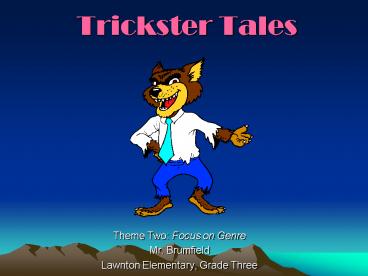Trickster Tales - PowerPoint PPT Presentation
1 / 26
Title:
Trickster Tales
Description:
A character who plays tricks or pranks on others. Smart ... Do you think the characters had good reasons or bad reasons for playing tricks? ... – PowerPoint PPT presentation
Number of Views:7083
Avg rating:3.0/5.0
Title: Trickster Tales
1
Trickster Tales
- Theme Two Focus on Genre
- Mr. Brumfield
- Lawnton Elementary, Grade Three
2
What are Trickster Tales?
- A trickster tale is a kind of folktale told all
over the world. - The trickster is a clever animal or person who
plays tricks on other characters. - Often its because the trickster is greedy or
boastful. - Sometimes though, another character outwits the
trickster!
Can you think of any trickster characters of
whom you are familiar?
3
Teacher Read Aloud
- Tyl Eulenspiegel and the Three Questions
- Retold by Matt Grace
What country or culture might this folktale have
been started? Clue Look at the characters name.
Challenging Vocabulary
Burgomaster the mayor of a German town Rascal or
Scoundrel someone who is tricky or
dishonest Impudent acting rudely or being
disrespectful
4
Questions about Tyl Eulenspiegel
- What problem does Tyl have to solve?
- How does the burgomaster try to outsmart Tyl?
- How does Tyl try to outsmart the burgomaster?
- How would you describe Tyls character?
5
Genre Vocabulary
- Boastfulness
- Clever
- Culture
- Folktale
- Greediness
- Mischief
- Qualities
- Trickster
Being full of praise for yourself
Smart
A group of peoples customs, beliefs, and
traditions
A traditional story handed down by generations
Selfishness
Bad behavior
Features that make a person special
A character who plays tricks or pranks on others
6
Applying the Vocabulary
boastfulness culture clever trickster greedin
ess
7
Applying the Vocabulary
culture mischief folktale qualities clever
8
Independent Vocabulary Practice
- Complete the vocabulary chart on page 177 of
your practice book.
9
Hungry Spider
Trickster Tale One
A Tale from Africa and the Ashanti Tribe
Based on the title and the genre, what do you
predict will happen in this story? When else
have we read or learned about the Ashanti people?
Told by Pleasant DeSpain
10
Character Traits
- Characters in folktales often have exaggerated
traits or personalities. - Authors reveal character traits through
- descriptions
- dialogue (conversations)
- the characters actions and reactions
Pay attention to the authors of character traits
throughout the story.
11
Hungry Spider Story Map
Steps Used in the Trick
Setting
Trickster
Tricksters Character Traits
Problem Trickster Needs to Solve
Results
12
Critical Thinking
- Why does the author begin the story with a
description of the Spider? - Why does Spider invite Turtle to dinner, even
though he doesnt want to share his food? - Why do you think Turtle invites Spider to dinner
after Spider treated him so badly?
13
Lesson to be Learned
- What lesson can we learn from this story?
14
Rabbit Races with Turtle
Trickster Tale Two
Have you heard any versions of this trickster
tale?
Told by Gayle Ross
15
Problems and Solutions
- Trickster tales always have a problem and
solution. - As you read, think about the different problems
and how each is solved.
Problems
Solutions
16
Critical Thinking
- How can you tell that this story is a trickster
tale? - In Hungry Spider, how does politeness cause
both Spider and Turtle to be tricked? - What details in Rabbit Races Turtle a good
trickster tale?
17
Compare Contrast
18
Genre Enrichment
Look for details about this story that make it a
trickster tale.
19
Aunt Fox and the Fried Fish
Trickster Tale Three
What will be the trick in this trickster tale?
Told by Rafael Rivero Oramas
20
Descriptive Language
- This author uses descriptive language, or words
that paint vivid pictures in the readers minds. - When we get to page 295 we will identify the
different examples of descriptive words.
21
Descriptive Language Enrichment
22
The Purposes of Descriptive Language
23
Critical Thinking
- What details does the author provide to show why
Aunt Fox eats the fish? - How is this story similar to and different from
the other two trickster tales? - Does this trickster tale teach a lesson or is it
written just to be entertaining?
24
Trickster Chart
- Complete the story chart on page 180 of your
practice book - You will be identifying the main parts of the
three trickster tales we have read.
25
Wrapping up our Focus
- Compare the tricks played by the characters
- Which do you think was the cleverest?
- Which one was the funniest?
- Do you think the characters had good reasons or
bad reasons for playing tricks? - Who was your favorite trickster and why?
26
Independent Comprehension































![Download [PDF] Mad Monk Improper Parables: Wit, Wisdom, Humor, Laughter and PowerPoint PPT Presentation](https://s3.amazonaws.com/images.powershow.com/10050043.th0.jpg?_=20240607088)